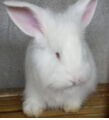目前市場上長毛兔的兔毛比較好而且這兩年國內對兔毛產品的開發有了突破性發展以前基本是原料出口量少價低現在在國內就能制成兔毛紗線、面料、服裝等出口穩定銷路看好。那么長毛兔怎么養才好?下面我們就一起來了解一下長毛兔的養殖要點吧!
At present, the price of rabbit hair of long haired rabbits in the market is relatively good, and there has been a breakthrough in the development of rabbit hair products in China in the past two years. In the past, it was basically that the export volume of raw materials was small and the price was low. Now it can be made into rabbit hair yarn, fabric and clothing in China. The export price is stable and the market is promising. So how to raise a long haired rabbit? Now let's learn about the breeding points of long haired rabbit!
1、品種挑選
1. Variety selection
對于長毛兔的基本品種知識大家了解多少呢?世界上長毛兔的品種很多其中以安哥拉兔為生產性能好的一個品種原產地在土耳其安哥拉省。安哥拉長毛兔品系很多如中系、英系、日系、德系等。其中以德系體重較大成年體重5公斤左右年產毛量在0.75~1公斤者可達到1.5公斤。中系安哥拉長毛兔適應性強繁殖率高耐粗飼抗病力強與德系安哥拉長毛兔雜交具有良好的配合能力。
How much do you know about the basic breed knowledge of long haired rabbit? There are many varieties of long haired rabbits in the world, among which Angora rabbit is a variety with good production performance, and its origin is in Angola Province, Turkey. There are many Angora long hair rabbit strains, such as Chinese, British, Japanese, German and so on. Among them, the weight of the German family is larger, the adult weight is about 5kg, and the annual gross output is 0.75 ~ 1kg, and the excellent can reach 1.5kg. The middle Angora long hair rabbit has strong adaptability, high reproductive rate, strong resistance to rough feeding and strong disease resistance. It has a good cooperation ability with German Angora long hair rabbit.
2、兔舍建設
2. Rabbit house construction
長毛兔有膽小怕驚、耐寒怕熱、厭濕喜干等生活習性因此兔舍必 需建在向陽、冬暖夏涼、光線充足、通風良好、空氣新鮮、干燥而幽靜的地方。圈舍新建或利用房前屋后、豬牛圈改造都要根據飼養量大小建設單列、雙列、多列式圈舍。
Long haired rabbits have the living habits of timidity and fear of shock, cold and heat resistance, aversion to humidity and dryness. Therefore, the rabbit house must be built in a sunny, warm winter and cool summer, sufficient light, good ventilation, fresh air, dry and quiet place. Single row, double row and multi row houses shall be built according to the feeding volume for the new construction of houses or the transformation of pig and cattle pens.
單列式:跨度2.5米左右設走道1.2米糞溝0.8米。兔籠面積占兔舍總面積30%左右。
Single row type: with a span of about 2.5m, a walkway of 1.2m and a dung ditch of 0.8m are set. The area of rabbit cage accounts for about 30% of the total area of rabbit house.
雙列式:兔籠分“面對面”或“背靠背”兩種。“面對面”布置兔籠中間設走道1.2米兩邊糞溝0.8米兔籠面積占兔舍總面積52%;“背靠背”布置兔籠兔籠兩面設走道1.2米中間設糞溝1米兔籠面積占兔舍總面積的32%。
Double row: Rabbit cages are divided into "face-to-face" or "back-to-back". "Face to face" arrangement: 1.2m walkway is set in the middle of the rabbit cage, 0.8m dung ditch on both sides, and the area of the rabbit cage accounts for 52% of the total area of the rabbit house; Rabbit cages are arranged "back to back", with 1.2m walkways on both sides and 1m dung ditch in the middle, accounting for 32% of the total area of the rabbit house.
3、飼養管理
3. Feeding management
一般飼養管理:采用籠養的方式即按照生產兔一籠一兔仔兔一窩一籠幼兔逐漸分籠種兔公母分開飼養。一般情況下飼喂3次即早晨日糧(精料和草)的三分之一傍晚喂日糧的三分之二夜間10點左右加喂一次草料每天少喂給200~300克新鮮青草或多汁飼料每天按時喂水給仔兔喂奶打掃衛生糞便每周要進行預防性1次。
General feeding management: cage feeding is adopted, that is, according to the production of rabbits, a cage of rabbits, a nest of rabbits and a cage of young rabbits, the breeding rabbits are gradually divided into cages, and the male and female rabbits are raised separately. Generally, feed three times a day, that is, one-third of the morning diet (concentrate and grass), two-thirds of the evening diet, and feed forage at least 200 ~ 300 grams of fresh grass or juicy feed every day, feed water to the young rabbits every day, clean and remove the feces, and carry out preventive disinfection once a week.
長毛兔喜食的青飼料很多如苜蓿、菜葉、各種樹葉、沙打旺、花生秧、紅薯秧及各種野菜等冬季可喂曬制的青干草。配合飼料的參考配方是:豆粉15%麩皮28%大麥15%玉米10%米糠20%魚粉5%棉籽餅5%貝殼粉1.5%食鹽0.5%。日糧中粗蛋白質含量為18%粗纖維11%可消化能量為每公斤12.5兆焦。
Long haired rabbits like to eat a lot of green fodder, such as alfalfa, vegetable leaves, various leaves, Astragalus adsurgens, peanut seedlings, sweet potato seedlings and various wild vegetables, which can be fed with dried green hay in winter. The reference formula of compound feed is: soybean flour 15%, bran 28%, barley 15%, corn 10%, rice bran 20%, fish meal 5%, cottonseed cake 5%, shell powder 1.5%, salt 0.5%. The content of crude protein was 18%, crude fiber was 11%, and digestible energy was 12.5 mj per kg.



 發布日期:2021-10-14
來源:http://guijingwen.cn 發布人:admin
發布日期:2021-10-14
來源:http://guijingwen.cn 發布人:admin